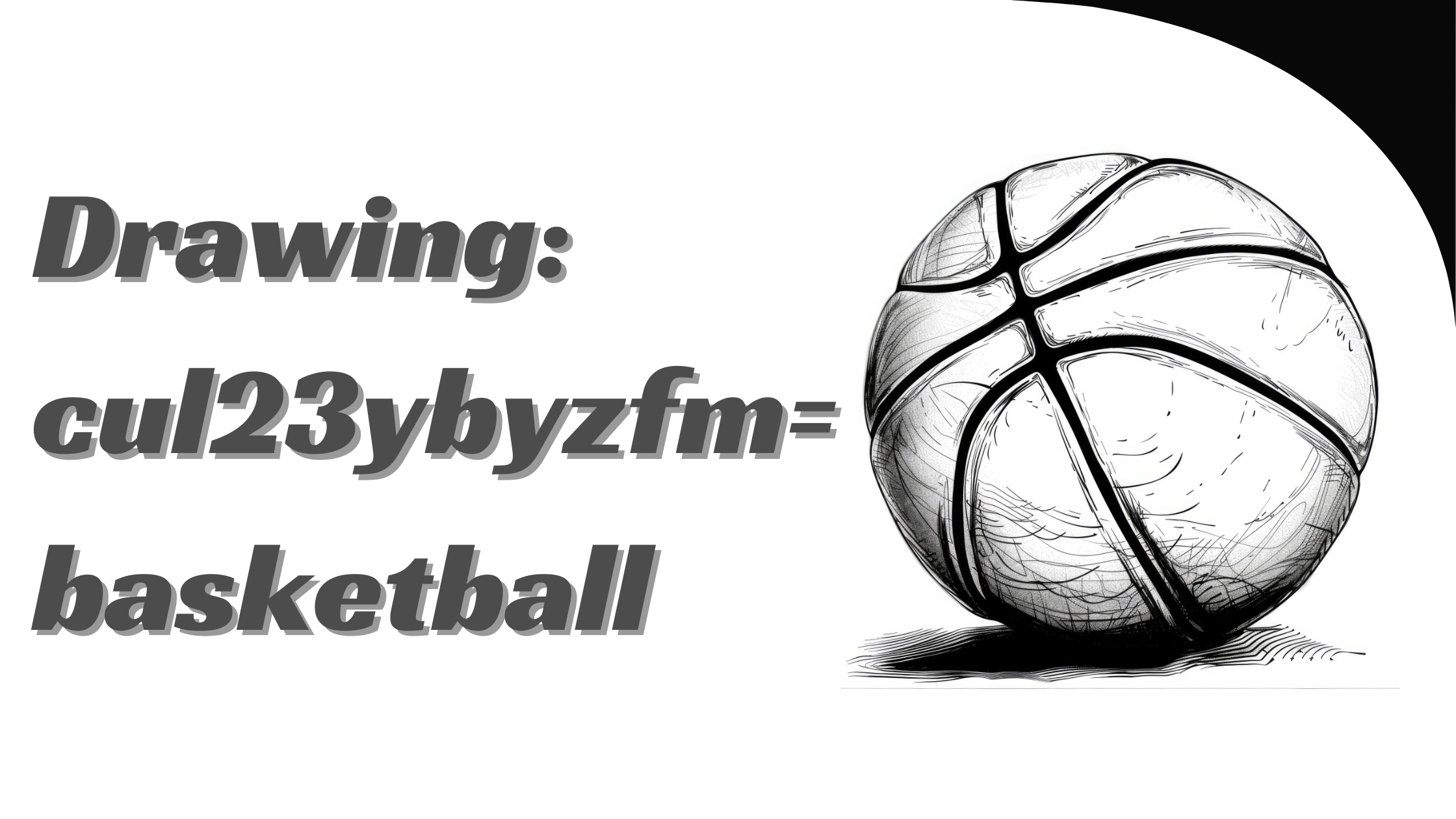Mastering the Art of “drawing:cul23ybyzfm= basketball”: A Comprehensive Guide to Capturing the Game on Canvas

Introduction
drawing:cul23ybyzfm= basketball, with its fast-paced action and dynamic plays, is not just a sport but a visual spectacle full of energy and emotion. For artists and enthusiasts alike, capturing the essence of basketball through drawing presents a unique challenge and opportunity. The concept of “Drawing
=” Basketball refers to a specialized approach or collection of techniques used to illustrate this thrilling sport. This article will delve into the intricacies of drawing basketball, providing detailed insights, tips, and techniques to help you master this art form.
1. Understanding the Fundamentals of Drawing Basketball

Before diving into the specifics of “drawing:cul23ybyzfm= basketball“, it’s crucial to grasp the basic principles of drawing this vibrant sport. Understanding these fundamentals will serve as the foundation for creating dynamic and engaging basketball artwork.
The Dynamics of the Basketball Movement
drawing:cul23ybyzfm= basketball is a sport characterized by rapid and fluid movements. Players are constantly running, jumping, dribbling, and shooting, making it essential for artists to capture these dynamic motions accurately. Observing the game’s natural flow and translating it into a static drawing requires a solid understanding of human anatomy and movement.
Anatomy of Basketball Players
drawing:cul23ybyzfm= basketball players involves understanding their anatomy and how it changes during different actions. Players’ muscles, joints, and posture shift dynamically with every move they make. Studying human anatomy, including muscle structure and movement mechanics, is essential for creating realistic and proportionate figures. Incorporate references such as photographs or live sketches to better understand these nuances.
Elements of Basketball Action
Incorporating key elements of drawing:cul23ybyzfm= basketball action into your drawings can significantly enhance their realism and appeal. Focus on essential aspects such as the ball’s trajectory, players’ gestures, and the overall composition of the scene. Capturing the intensity and energy of a game often involves depicting these elements in a way that conveys motion and excitement.
2. Techniques for Drawing Basketball Players
drawing:cul23ybyzfm= basketball players requires a blend of technical skills and creative insight. Here, we’ll explore several techniques to help you capture the essence of players in action.
Gesture Drawing
Gesture drawing:cul23ybyzfm= basketball is a technique used to quickly capture the basic form and movement of a subject. In the context of basketball, gesture drawing can help you sketch out the dynamic poses and actions of players. Focus on the overall flow and rhythm of the players’ movements rather than fine details. This technique is useful for creating preliminary sketches and understanding the composition of your drawing.
Proportions and Perspective
Accurate proportions and perspective are crucial when drawing:cul23ybyzfm= basketball players. Pay attention to the relative sizes of different body parts and how they change based on the players’ actions. For instance, a player jumping to shoot will have a different body proportion compared to when they are dribbling. Additionally, applying perspective techniques can help create a sense of depth and realism in your drawings, making the action appear more dynamic.
Detailed Rendering
Once you have the basic sketch and proportions established, you can move on to detailed rendering. Focus on capturing the texture of the players’ uniforms, the contours of their muscles, and the surface of the basketball. Detailed rendering involves paying attention to light and shadow, which adds dimension and realism to your drawing. Techniques such as cross-hatching, stippling, and blending can be used to achieve these effects.
3. Drawing Basketball Courts and Environments
A complete drawing:cul23ybyzfm= basketball often includes the court and surrounding environment, which adds context and enhances the overall composition. Understanding how to draw these elements can elevate your artwork.
Court Layout and Details
The drawing:cul23ybyzfm= basketball court is an integral part of the drawing that sets the stage for the action. Study the layout of a standard basketball court, including the key areas such as the three-point line, free-throw line, and the hoop. Pay attention to the court’s markings, textures, and the surrounding environment, such as the stands and scoreboard. Accurate representation of these details helps ground your drawing in realism.
Background and Foreground
Incorporating background and foreground elements adds depth to your drawing:cul23ybyzfm= basketball. The background might include the crowd, arena, or cityscape, while the foreground focuses on the players and the immediate action. Ensure that these elements are well-integrated and do not distract from the main subject. Use techniques such as atmospheric perspective to create a sense of depth and distance.
Lighting and Shadows
Proper lighting and shadows are essential for creating a realistic and immersive drawing:cul23ybyzfm= basketball scene. Analyze how light sources affect the court, players, and surroundings. The direction of light influences the shadows and highlights on the players and court. Incorporate these elements into your drawing to enhance the three-dimensionality and dynamic nature of the scene.
4. Capturing Key Moments in Basketball
drawing:cul23ybyzfm= basketball specific moments in basketball can be particularly challenging and rewarding. Key moments often encapsulate the intensity and excitement of the game.
Action Shots
Action shots capture pivotal moments, such as a slam dunk, a fast break, or a dramatic three-pointer. To effectively draw these moments, observe how players’ bodies and movements change during these high-energy plays. Focus on the players’ expressions, the ball’s trajectory, and the overall composition of the scene. Capturing the peak of action can convey the thrill and emotion of the game.
Emotional Expressions
drawing:cul23ybyzfm= basketball is not only about physical action but also about emotional intensity. Players’ faces often reflect their concentration, determination, or celebration. Pay attention to the subtle expressions and emotions that convey the narrative of the game. Drawing these expressions accurately can add depth and personal connection to your artwork.
Team Dynamics
drawing:cul23ybyzfm= basketball is a team sport, and capturing the dynamics between players can add another layer of interest to your drawing. Depicting interactions, teamwork, and the strategic aspects of the game can provide a richer narrative. Show how players support each other, execute plays, and react to the game’s unfolding events.
5. Tools and Materials for Drawing Basketball
Choosing the right tools and materials can significantly impact the quality of your basketball drawings. Here’s a guide to help you select the best options for your artistic needs.
Drawing Mediums
Different drawing:cul23ybyzfm= basketball mediums offer varying effects and styles. Pencils are versatile and ideal for detailed work and shading. Ink pens provide bold lines and high contrast, while markers and colored pencils can add vibrant hues. Experiment with different mediums to find what works best for capturing the energy and detail of basketball.
Paper Types
The type of paper you use can affect the final appearance of your drawing:cul23ybyzfm= basketball. Choose paper that suits your medium—smooth paper for detailed pencil work, textured paper for more expressive strokes, or mixed-media paper for versatility. Ensure the paper weight and texture support the techniques you plan to use.
Digital Tools
Digital drawing tools and software offer additional options for creating basketball artwork. Programs like Adobe Photoshop, Procreate, and Clip Studio Paint allow for easy editing, layering, and color application. Digital tools also provide flexibility in terms of revising and refining your drawings.
6. Inspiring Artists and Influences
Studying the work of other artists can provide inspiration and insight into drawing basketball. Here are some notable artists and influences that may spark your creativity.
Sports Illustrators
Many artists specialize in sports illustration, capturing the essence of various games through their work. Look at the portfolios of sports illustrators who focus on basketball to understand their techniques and styles. Analyzing their use of composition, movement, and detail can offer valuable lessons for your drawings.
Famous Basketball Artworks
Explore famous artworks related to basketball, including posters, murals, and paintings. These works often highlight key moments or iconic players and can serve as inspiration for your projects. Pay attention to how different artists convey movement, emotion, and energy in their representations of the sport.
Contemporary Trends
Stay updated on contemporary trends in basketball art and design. Modern artists may use innovative techniques, styles, and digital tools to create dynamic and engaging artwork. Embracing these trends can help you stay current and infuse fresh ideas into your drawings.
7. Challenges and Solutions in Drawing Basketball
Drawing basketball presents unique challenges, but with the right strategies, you can overcome them and create impressive artwork. Here are some common challenges and solutions.
Capturing Movement
One of the biggest challenges in drawing basketball is capturing movement and action. To address this, use gesture drawing techniques to quickly sketch the dynamic poses and movements. Observe real games or practice with live models to understand how players move and interact. Animation references or video clips can also be helpful.
Maintaining Proportions
Ensuring accurate proportions in dynamic poses can be difficult. Use guidelines and reference images to maintain consistency in body proportions and perspective. Regularly check your drawing against anatomical references to ensure accuracy and realism.
Balancing Detail and Simplicity
Finding the right balance between detail and simplicity can be challenging. Too much detail can overwhelm the viewer, while too little may not convey the action effectively. Focus on key elements that highlight the main features of the scene. Prioritize details that enhance the overall impact of the drawing without cluttering the composition.
8. Showcasing and Sharing Your Basketball Drawings
Once you’ve completed your basketball drawings, sharing them with others can be a rewarding experience. Here’s how to effectively showcase and share your artwork.
Creating a Portfolio
Build a portfolio to display your basketball drawings and other artworks. A well-organized portfolio showcases your best work and demonstrates your skills and style. Include a variety of pieces that highlight different aspects of basketball and your artistic range.
Online Platforms
Share your artwork on online platforms such as social media, art communities, and personal websites. Platforms like Instagram, DeviantArt, and Behance provide opportunities to reach a broader audience and connect with fellow artists. Use hashtags and keywords related to basketball art to attract viewers interested in your work.




